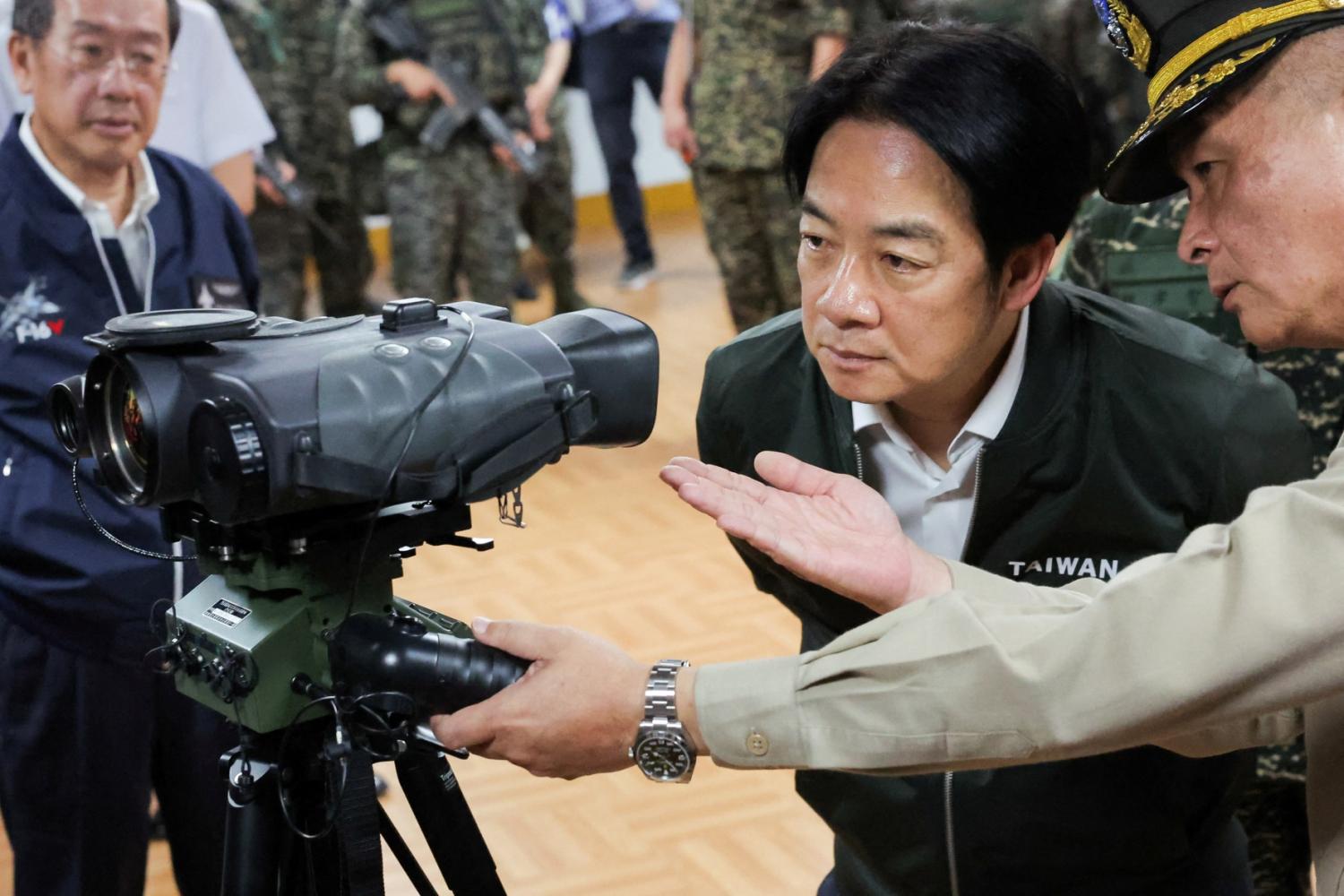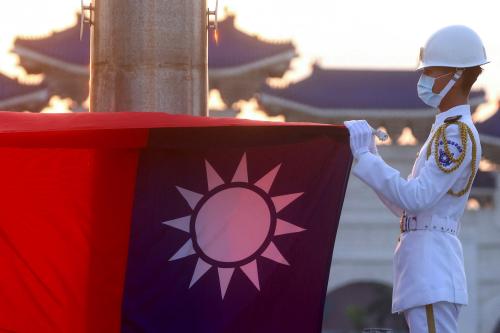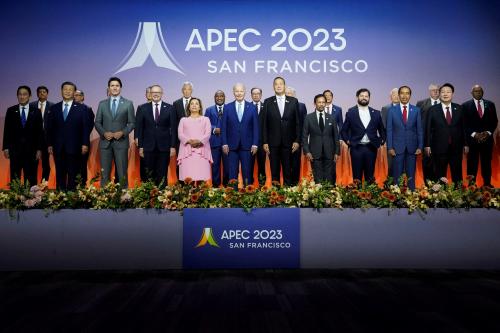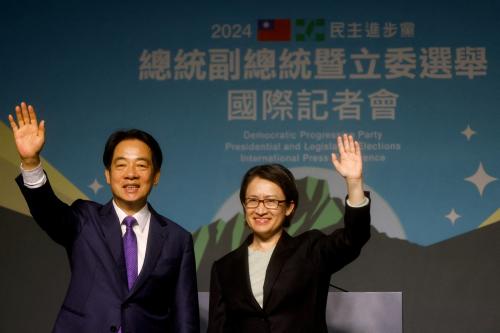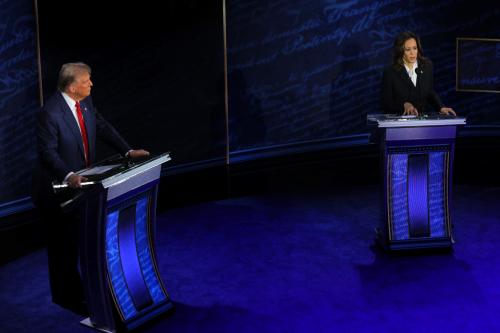Executive summary
As countries confront complex external threats, their leaders often seek to forge grand strategies to organize tools of statecraft for protecting and advancing national interests. Taiwan presently faces a threat of annexation from the People’s Republic of China, in addition to shifts in the global economy that could erode Taiwan’s competitive position. In the face of these threats, Taiwan’s newly elected leader, President Lai Ching-te, appears to be forging a grand strategy designed to secure Taiwan’s political autonomy and democratic governance. This emerging grand strategy rests on four pillars: developing whole-of-society resilience; pursuing active diplomacy with other key powers; raising international awareness of Taiwan’s indispensability to the global economy; and building asymmetric defensive capabilities. To make progress in advancing this strategy, the Lai administration will need to overcome deepening domestic political divides as well as challenges to Taiwan’s well-being, such as limits on energy supply and demographic headwinds. How well Lai succeeds in building support for his vision will go a long way toward determining the future of Taiwan and the direction of cross-Strait relations.
What is a grand strategy?
Countries develop grand strategies to mobilize and organize actions to achieve long-term national objectives. Grand strategies often aim to align diplomatic, military, political, economic, and technological policies in pursuit of defined goals. These strategies are used as guideposts to help countries navigate complex and evolving international environments.
Leaders often embrace grand strategies to build support behind their visions and to justify sacrifices in service of them. Leaders also use grand strategies to signal their resolve and their ambitions to allies and adversaries. For example, successive American presidents pursued a grand strategy of containment of the Soviet Union to limit the spread of communism during the Cold War. During the 19th century, the United States established the Monroe Doctrine to block European colonialism in the Western Hemisphere and assert American hegemony in its periphery. In 19th-century Europe, Otto von Bismarck pursued a grand strategy of realpolitik to maintain balance and stability amidst shifting alliances.
During recent discussions in Taipei with Taiwan’s leaders, it became clear that Taiwan has the makings of an emerging grand strategy. This emerging grand strategy is organized to support Taiwan’s preservation of its political autonomy and democratic governance in the face of external threats. The most proximate and existential threat is Beijing’s desire to annex Taiwan and bring its 23 million people under the rule of the Chinese Communist Party. Taiwan also faces potential challenges from the global economy’s shift toward greater regionalization and fragmentation.
The challenge for Taiwan of building a durable grand strategy is made more difficult by the absence of societal consensus on the best way to protect Taiwan’s autonomy and democratic character. This conceptual divide has persisted for over 25 years and shows no sign of abating anytime soon. On the one hand, a portion of the population believes the best course is to deepen connections across the Taiwan Strait to help lower tensions with Beijing. This group judges that deeper cross-Strait engagement could reshape China’s intentions, or at a minimum, lessen China’s sense of urgency to annex Taiwan. On the other hand, a segment of Taiwan’s population believes that Beijing’s appetite for absorbing Taiwan cannot be quelled short of capitulating to unification. In this view, rather than seek to accommodate Beijing, Taiwan must instead align with strong democratic partners, foremost the United States, to deter China’s use of coercion or force in pursuit of its aims. This societal divide on how best to deal with Beijing is one of the most formidable obstacles for Taiwan’s leaders seeking to adopt an enduring grand strategy that can attract broad buy-in.
This conceptual divide notwithstanding, there is a large and growing consensus within Taiwan’s society on the goal of preserving the cross-Strait status quo. There is no uniform definition of what constitutes Taiwan’s status quo, but for purposes of this paper, it will be considered as including the following conditions: the absence of conflict; Taiwan’s political autonomy and democratic self-governance; and Taiwan’s control over its own economy, security, and diplomacy.
According to a longitudinal poll conducted by the National Chengchi University Election Study Center, 88.8% of respondents support some form of the status quo, even as they hold varying views on what should constitute Taiwan’s long-term status in relation to the People’s Republic of China (PRC). Taiwan’s political leaders understand this public preference and compete to demonstrate who would best protect Taiwan’s current status. In Taiwan’s January 2024 election, voters split the difference, electing incumbent Democratic Progressive Party Vice President Lai Ching-te as president and giving the largest number of seats in the Legislative Yuan to the opposition Kuomintang party.
Four pillars of Taiwan’s grand strategy
Under Lai, the outlines of Taiwan’s grand strategy appear to be coming into focus. During a Brookings Institution study tour to Taipei from August 6-10, several colleagues and I had an opportunity to engage with Taiwan’s top leaders and their advisors on their plans in a series of in-depth discussions. Taiwan’s top leaders also have laid out many of their policies and goals in their public statements since taking office on May 20. Based on these recent discussions and a review of public statements made by Taiwan’s leaders, Taiwan’s emerging grand strategy appears to rest on four key pillars.
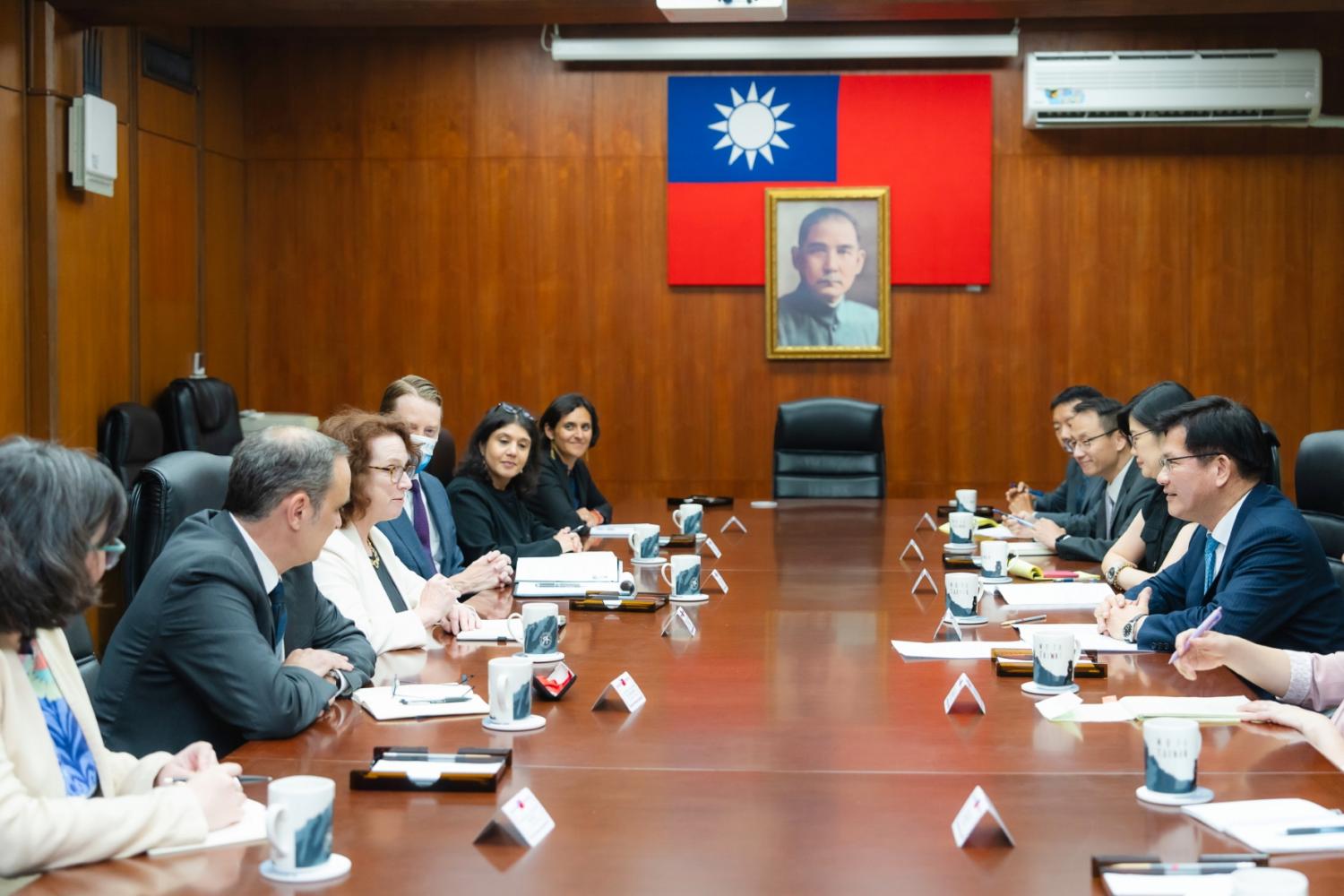
Brookings delegation meets with Taiwan’s minister of foreign affairs, Lin Chia-Lung (center right). (Ministry of Foreign Affairs, ROC)
1. Promote societal resilience
The Lai administration does not believe Beijing’s strategic appetite for absorbing Taiwan can be sated through dialogue, reassurance, or deeper economic integration. Rather, Lai and his team judge that Taiwan must bolster deterrence and disabuse Beijing of any notions that the PRC could gain control of Taiwan at low cost or risk. Lai’s personal focus for doing so involves strengthening Taiwan’s whole-of-society resilience.
Lai proclaimed on June 19 that he would lead an effort to mobilize all of Taiwan to become more resilient. In announcing this initiative, Lai declared, “The world is watching how Taiwan can demonstrate strong resilience in defending itself and deter the ambitions that seek to disrupt regional peace and stability. Only when our entire society possesses a strong will for self-defense and an unwavering confidence in ourselves can Taiwan effectively respond to various disasters and risks and grow stronger.”
Lai seeks to build a civic identity in Taiwan of toughness, the capacity to weather shocks, and confidence in the future. This requires Taiwan’s leaders to walk a tightrope between spurring public preparedness without sparking panic, which could scare off multinational corporations and inbound investment into Taiwan. Several Taiwan leaders acknowledged in meetings with the Brookings delegation that striking such a balance is more of an art than a science and will require constant calibration.
To help push resilience efforts forward, Taiwan’s various ministries have invested roughly $26.4 billion in six priority areas: command and control/strategic communication; social welfare and medical supplies; material preparations and critical supply distribution systems; civilian forces training and utilization; energy and critical infrastructure security; and information, cyber, transportation, and financial security.
In prioritizing societal resilience, Lai also aims to alert Taiwan’s population to threats posed to Taiwan by actions short of war, what my Brookings colleague Richard Bush has coined as Beijing’s strategy of “coercion without violence.” This approach by Beijing employs nonviolent actions to erode Taiwan’s political unity and undermine public confidence in Taiwan’s future. Actions by Beijing in support of such a strategy include Chinese cyber intrusions to induce doubt about the reliability of public services, interference in Taiwan’s democratic processes, and the use of economic inducements and punishments to shift public sentiment in directions favorable to Beijing’s goals.
In raising public awareness about the importance of whole-of-society resilience, Lai seeks to highlight that self-defense is broader than a measure of military capabilities or public polling on a society’s readiness to fight. To promote greater societal involvement in Taiwan’s security, Lai chairs a whole-of-society resilience committee. This high-level group aims to galvanize actions to strengthen resilience. Although former President Tsai Ing-wen also highlighted the importance of fostering domestic resilience during her tenure, she did not institutionalize or prioritize this issue to the same extent as Lai has.
A key challenge going forward will be to move coordination of such efforts beyond ministers and national security experts. For this pillar to be effective, it will require broad and deep buy-in from mid-level officials throughout government, as well as civil society leaders, businesses, universities, public service employees, and everyday citizens. Even if programs get launched and enjoy moderate success, Taiwan’s population must continually be convinced that the programs are tangible and are making them more secure. This will require active and concerted efforts and public communication from a broad range of Taiwan’s leaders inside and outside of government.
2. Launch “active diplomacy”
Since assuming office, Foreign Minister Lin Chia-lung has emphasized that Taiwan must be a giver to and not a taker of international security and development. He is integrating economic issues into Taiwan’s traditional diplomacy in new ways. Like his predecessor, Joseph Wu, Lin also continues to emphasize a values-based approach to Taiwan’s international relations. He believes Taiwan’s best friends around the world will be democracies that uphold individual liberties. Lin also has eschewed efforts to compete with Beijing for diplomatic allies through bribes or preferential financing.
Lin views Russia’s invasion of Ukraine as having alerted Taiwan people to the need to become more active internationally. Ukraine’s experience highlighted for Taiwan the criticality of having strong partners before crises erupt, rather than scrambling to build relationships with key actors in the fog of war. To help Taiwan strengthen partnerships with key countries, Lin believes Taiwan must leverage its unique position at the center of global value chains for information and communication technology (ICT). Taiwan’s leaders and diplomats can employ their experiences melding technology, talent, and capital to climb value chains to strengthen relationships with key partners around the world.
Under Lin, Taiwan is working to develop closer links with countries such as the Philippines, India, Thailand, Lithuania, and the Czech Republic. Taiwan is offering support to its partners in building science parks and incubating new innovations, potentially including smart agriculture, smart cities, smart medicine, the Internet of Things, and semiconductor manufacturing and packaging. Taiwan wants to share its unique experiences with other leaders who aspire to unlock opportunities for their peoples. Over the past 40 years, Taiwan has succeeded in building the world’s leading ICT ecosystem. Such efforts have supported growth in Taiwan’s per capita GDP from around $1,900 in 1984 to around $35,000 now.
Many countries likely will welcome closer economic interaction with Taiwan, particularly countries that have strained political relations with China. For Lin’s vision of “active diplomacy” to yield results in strengthening Taiwan’s international relationships, though, the Lai administration will need to enlist significant involvement and support from Taiwan’s private sector. This presents a challenge, given that Taiwan’s leading firms, such as Taiwan Semiconductor Manufacturing Company (TSMC), protect their corporate independence and take a long-term and strategic view on major capital expenditures. Thus, a key challenge for Lin’s vision of “active diplomacy” will be securing buy-in from Taiwan’s private sector for employing economic tools to strengthen Taiwan’s relationships around the world.
Ultimately, a key measure of the strategic value of Taiwan’s pursuit of “active diplomacy” will be how well Taiwan is able to enlist partners who would be prepared to threaten and if necessary, impose severe economic sanctions if China attacks Taiwan. To contribute meaningfully to deterrence, Taiwan may need to begin building such a coalition in waiting now. Such efforts likely would have more impact if pursued quietly than if every advance and setback down this path becomes a matter of public record. Beijing no doubt has ample means to understand where diplomatic discussions between Taiwan and its partners stand short of reading about them in the Financial Times.
3. Promote indispensability to the global economy
Lai seeks to elevate international awareness of Taiwan’s central role in the functioning of the global economy. He views this awareness as essential for attracting other countries to increase support for Taiwan, including by speaking out for preserving cross-Strait peace and stability; deepening economic and social links; expanding political connections; and potentially providing support for Taiwan’s defense in the event of a crisis. Such efforts also support Lai’s domestic political imperative to demonstrate that he can gain greater global backing to counterbalance growing PRC pressure on Taiwan.
Lai gave clear expression to this element of his grand strategy during a press conference to mark his first month in office as president. He explained:
“Taiwan occupies a strategic position on one of the world’s busiest shipping lanes; we play a crucial role on the frontline of the democratic world; our advanced supply chains hold the key to the next generation of technological development. The Taiwan of today is a Taiwan of the world. Anything that happens to Taiwan could send ripples through the entire globe. Therefore, Taiwan’s issues are international issues, and international issues are Taiwan’s issues.”
Taiwan’s leading companies will be essential for powering the next wave of global innovations in artificial intelligence (AI) and in other sectors. Leading global companies such as Nvidia, Microsoft, and AMD are expanding in Taiwan and helping it become the world’s “AI island.” Taiwan’s leaders recognize the risk of overdependence on the chip sector, though, and have been looking for other sectors where Taiwan could build a comparative advantage. Lai has highlighted clean energy, next-generation communications satellites, unmanned autonomous vehicles, and maritime industries as potential areas for Taiwan’s industrial expansion.
Lai also is working to make Taiwan more global-facing and less China-reliant for its economic growth. According to Taiwan government statistics, Taiwan’s outbound investment in China has dropped from a peak of 83.8% in 2010 to less than 12% in 2023. Much of the diverted investments are being poured back into Taiwan or into South and Southeast Asia as part of Taiwan’s “New Southbound Policy.” Like his predecessor, Lai has touted this trend and said Taiwan will further seek to diversify trade by focusing on opportunities outside the PRC.
Recent studies confirm the trend of Taiwan companies de-risking from exposure to the Chinese market. For example, China expert Scott Kennedy at the Center for Strategic and International Studies noted in September that over 57% of some 610 Taiwanese companies surveyed late last year were either moving or considering moving from mainland China. Those surveyed cited a worsening business environment in China and concerns about a possible conflict in the Taiwan Strait as factors informing their planning.
Taiwan companies were among the first to enter the Chinese market after Beijing began reform and opening in the late 1970s. They now appear to be leading the trend of corporate departures from the China market. While this corporate trend is notable, it has not yet been matched by policy support in securing more market access or trade liberalization for Taiwan companies in other overseas markets.
Progress on trade liberalization and market access may be difficult in the short run, particularly in Asia, where China maintains leverage to prevent Taiwan from joining regional trade pacts. China is a member of the Regional Comprehensive Economic Partnership and will use its position to block Taiwan’s entry. Beijing also will press for Taiwan not to be admitted into the Comprehensive and Progressive Trans-Pacific Partnership (CPTPP) before China gains membership. Given that CPTPP requires unanimous support for the entry of new members, Beijing likely will be able to find a combination of carrots and sticks to pressure at least one current member to hold up Taiwan’s admission. Taipei may need to look outside of Asia for openings to expand trade links with other developed economies, potentially including Canada, the United Kingdom, and the United States.
4. Build asymmetric defense
Taiwan’s military establishment is populated with the most reform-minded leadership since its transition to direct democratic elections in 1996. Defense Minister Wellington Koo and his deputies are steadily shifting away from big-ticket platforms toward asymmetric capabilities that maximize Taiwan’s geographic advantages. Investments in such a strategy are designed to enhance the Taiwan military’s mobility and survivability in halting enemy advances, while avoiding getting drawn into efforts to match China’s military capabilities, which Taiwan cannot afford to do. Examples of such investments include sea mines, drones, and portable anti-ship and anti-air missiles.
At the same time, Taiwan is steadily increasing its investment in its defense. According to government figures provided to the Brookings team during its visit, Taipei has increased its defense budget by 80.47% in the past eight years and plans to raise defense spending by more than 5% in 2024. This places Taiwan’s rate of growth in defense spending above other regional countries, including Australia, Japan, and South Korea. Even so, Taiwan’s defense spending on a per capita basis remains below other democratic peers who face existential threats, such as Israel, Poland, and South Korea.
Taiwan Ministry of National Defense (MND) also is having the military train in realistic conditions and no longer use exercises to demonstrate proficiency in previously rehearsed maneuvers. Taiwan’s forces are expanding both the quantity and quality of their training. MND is investing greater resources in its reserve force. Taiwan’s coast guard also is building interoperability with other regional coast guards, including through efforts to strengthen disaster response capabilities with counterparts from the Philippines and Japan.
While these advances are notable and praiseworthy, they cannot be viewed in a vacuum. They must be weighed against the progress that Beijing is making in improving its own capability to undertake complex missions near Taiwan. Viewed in this light, Taiwan’s MND is right to act with urgency. China is rapidly fielding new capabilities that could be used in cross-Strait contingencies. Chinese forces also are demonstrating growing proficiency in conducting complex joint operations in the waters and airspace surrounding Taiwan.
Taken together, these four pillars—resilience, active diplomacy, indispensability, and asymmetric defense—appear to comprise the building blocks of Taiwan’s grand strategy for preserving autonomy and democratic governance.
What could go wrong?
In its first months in office, the Lai administration has begun identifying the elements of Taiwan’s grand strategy, allocating resources to build these pillars, and developing the bureaucratic infrastructure to advance its vision. These are commendable and important steps. At the same time, other formidable obstacles remain that could stymie progress if not handled effectively. The most critical obstructions could come from energy shortfalls and demographic headwinds that could sap Taiwan’s economic vitality, as well as from political divisions.
Taiwan’s inherent strength comes from its private sector and its vibrant society. Taiwan’s economy provides the foundation for its national security and its stature in the world. In recent years, Taiwan’s economy has enjoyed strong growth. Taiwan’s Directorate General of Budget, Accounting, and Statistics projects growth to remain strong in 2024, with estimates of a nearly 4% expansion in GDP, driven by rising export demand and domestic consumption.
Looking further out, Taiwan will require smart policies to navigate through potential obstacles to growth. Two of the most salient challenges are access to energy and an aging workforce. Taiwan’s energy mix is heavily reliant on imports of fossil fuels. Successive governments have pledged to increase renewable energy as Taiwan works toward a net-zero emission target by 2050. Even so, Taiwan’s renewable energy generation, storage, and transmission are not coming online fast enough to meet rising energy demand. Lai may need to buck his political party’s anti-nuclear position if he intends to bolster energy security and keep Taiwan on track with its clean energy targets. Lai and his surrogates already have begun signaling that the new government will be pragmatic and science-based in reaching a decision on the use of nuclear in Taiwan’s energy mix. Lai also has included nuclear energy on the agenda in the newly formed National Climate Change Response Committee that he chairs.
A second major challenge is Taiwan’s aging workforce. Taiwan faces a shortage of talent amidst a shrinking population. This threatens long-term economic growth. Taiwan authorities have attempted without success to incentivize population growth through subsidies. Looking ahead, greater policy efforts will likely be needed to address the root causes of declining fertility, including by offering greater access to child and elder care, affordable housing, and reductions in cost-of-living stresses on younger generations. Over time, Taiwan may also need to pursue reforms to its high-skilled immigration policies to attract more talent from abroad to sustain Taiwan’s technology-based growth model. Taiwan’s education system also will need to prioritize recruiting women to join science, technology, engineering, and mathematics fields. Progress in this direction would expand the talent base from which Taiwan’s leading firms can recruit.
Taiwan’s demographic challenges speak to a broader trend. Taiwan faces many of the same societal dilemmas as other high-income economies around the world. To overcome challenges such as low fertility, wealth inequality, and unequal access to opportunity, Taiwan will need to step outside of its own national narratives and draw lessons from other countries navigating similar challenges.
Taiwan’s domestic politics present another potential impediment to the Lai administration’s advancement of its grand strategy. Domestic political fractures have deepened in recent months. Part of this dynamic is structural. Taiwan returned to divided government in 2024 after an extended period when the presidency and legislature were controlled by the same party. The last notable period of divided government occurred during the era of former President Chen Shui-bian. Confronted with barriers to advancing policy initiatives through legislation, Chen turned his attention to rallying his political base to secure support for his reelection. A repeat of this pattern under Lai would imperil his efforts to advance Taiwan’s grand strategy. The only victor in such a scenario would be Beijing, which would relish the weakening of Taiwan from within.
To manage such risks, Lai will need to calibrate his political strategy for an era of divided government. He will need to be willing to share credit with political rivals and less sharp in drawing distinctions between parties. He will need to anchor his vision in the broadly shared goal of Taiwan’s public: preserving the status quo. He can lend weight to such efforts by tempering calls to play on identity politics. He could consistently emphasize his support for Taiwan’s existing constitutional order and his commitment to keeping cross-Strait policy stable and consistent. He also could continue to emphasize that under his leadership, Taiwan will neither yield nor provoke the PRC. None of these recommendations on their own would offer a silver bullet for overcoming Taiwan’s philosophical and political divides, but they would help preserve space for compromises and deals to be reached that could support Taiwan’s emerging grand strategy.
America’s role
America’s interests are best served by a strong and confident Taiwan that acts as a force for stability. The United States and Taiwan have a deep, strong, and healthy relationship. Washington and Taipei engage intensively on virtually every issue, from security to diplomacy, trade, public health, technology, education, and science. While the successful implementation of Taiwan’s grand strategy would matter greatly to America’s strategic interests, Washington’s ability to influence the results in each of its four pillars may only occur on the margins. This may be a blessing in disguise. The more that Taiwan’s progress in implementing its grand strategy is viewed as a product of the decisions and determination of the Taiwan people, and not as a project imposed on Taiwan by an overbearing partner, the more durable it may be.
On domestic resilience, the United States is not postured to share best practices. By dent of its geography, strength, and societal organization, the United States is not practiced in mobilizing around domestic resilience. Where Washington could offer support, though, is in sharing best practices on building disaster response capabilities and in helping foster links for Taiwan experts with Baltic and Nordic countries who are better organized around national resilience.
Similarly, commercial diplomacy is not a strength of America’s foreign policy. Presently, America’s politics are not supportive of trade liberalization. Washington is lacking ambition in its economic engagement with partners around the world. On a relative basis, Washington is more forward-leaning in strengthening economic ties with Taiwan through negotiation of the U.S.-Taiwan Initiative on 21st Century Trade. Both sides should continue to make steady progress in these efforts. In addition, Washington can and should urge other countries to partner with Taiwan around its “active diplomacy” agenda. U.S. officials also should drive forward planning with counterparts across the world on potential responses to Chinese aggression, should such a step ever become necessary.
American leaders can play an active supporting role in raising international awareness of Taiwan’s indispensability to the global economy, and in encouraging leaders from other countries to do the same. Greater public appreciation of this reality could open more political space for other countries to become more invested in advocating for the preservation of peace and stability in the Taiwan Strait. This would help disabuse any hopes in Beijing that cross-Strait issues could be dealt with as a domestic issue or as an annex of U.S.-China competition. The more Taiwan’s security becomes embedded as an issue that is critical to the functioning of the global economy, the higher the cost and risk to Beijing of using force to achieve its aims.
Lastly, on asymmetric defense, Washington can and should seek to spur progress. Over the years, security experts in Washington and Taipei have built channels to share best practices and exchange analyses of Taiwan’s threat environment and effective responses to those threats. Washington should use these interactions to support progress toward the development and fielding of asymmetric defensive capabilities and doctrine. As part of such efforts, Washington could help foster relationships for Taiwan with America’s ecosystem of emerging defense firms outside of the traditional five “primes”: Boeing, Raytheon, General Dynamics, Lockheed Martin, and Northrop Grumman. Co-production arrangements between newer American defense firms and Taiwan counterparts could help marry American innovation with Taiwan’s precision manufacturing in ways that would serve both sides’ interests.
At a broader level, America also has two other important roles to play in support of Taiwan’s grand strategy. The first is to offer quiet, candid counsel to Lai and his advisors. Unlike Taiwan’s previous two leaders, Lai does not have deep experience in foreign policy, including in dealing with Chinese counterparts. U.S. officials can discreetly support Lai’s ability to anticipate how Taiwan’s key partners and Beijing will interpret and respond to his statements and initiatives.
U.S. diplomats also can help foster communication between Taiwan’s competing political parties. Unlike past periods of divided government, there are no natural dealmakers in leadership positions of the various political parties. American diplomats may be able to provide their good offices to limit the risks of miscommunication and occasionally identify potential areas of compromise. Performing this role would require tact, discretion, and a credible commitment to remaining nonpartisan.
At the end of the day, even though much of the Western public commentary about cross-Strait relations focuses on military developments and debates about timelines for a potential PRC invasion of Taiwan, the lived reality for many people on the ground in Taiwan is much more complicated. For proponents of sustaining cross-Strait stability, the good news is that the Lai administration appears to be coalescing around four pillars of a grand strategy to support Taiwan’s political autonomy and democratic institutions. Now comes the hard part of building broad political and public support in Taiwan for this vision. Whether Lai can build broad public support for his vision and put resources and bureaucratic muscle behind its implementation will go a long way toward informing Taiwan’s future trajectory and the direction of cross-Strait relations.
-
Acknowledgements and disclosures
The author would like to thank Jennifer Mason for her assistance with this project, Kevin Dong for his research support, Rachel Slattery for web design, and Adam Lammon and Alexandra Dimsdale for assisting with the review and publication process. The author also would like to thank four blind peer reviewers for their assistance in sharpening the arguments in the piece.
The Brookings Institution’s August 2024 study tour to Taiwan was funded by a grant from the Taipei Economic and Cultural Representative’s Office.
The Brookings Institution is a nonprofit organization devoted to independent research and policy solutions. Its mission is to conduct high-quality, independent research and, based on that research, to provide innovative, practical recommendations for policymakers and the public. The conclusions and recommendations of any Brookings publication are solely those of its author, and do not reflect the views of the Institution, its management, or its other scholars.

